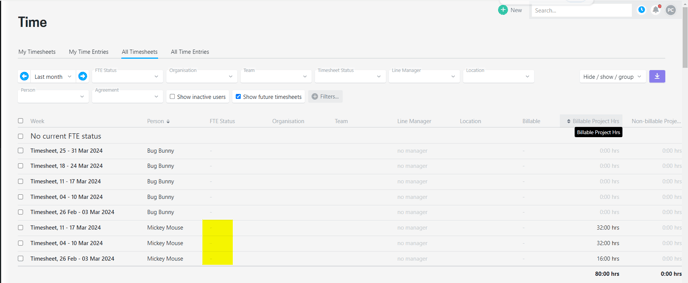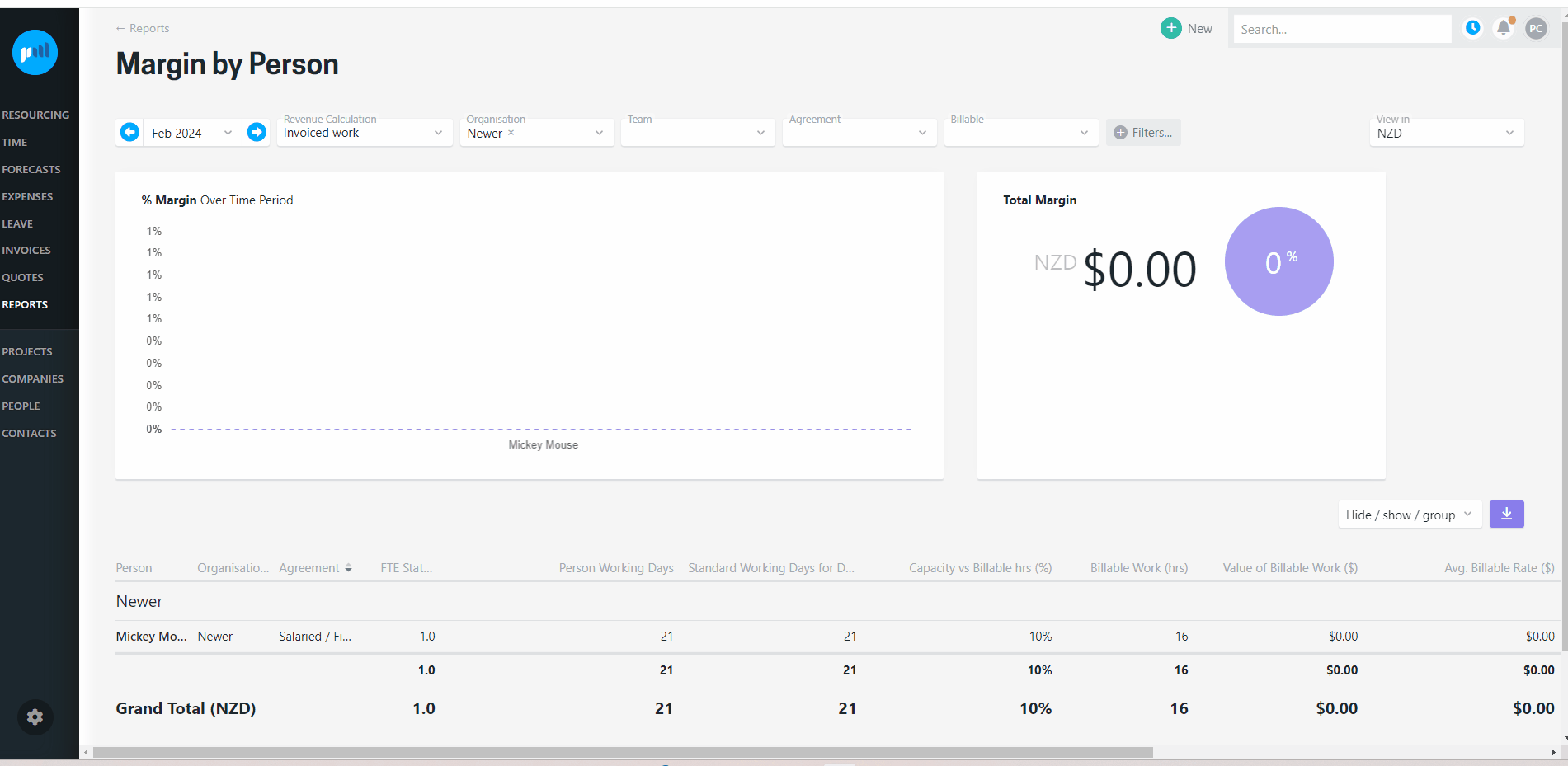A person’s weekly capacity establishes a person’s availability to work based on their employment agreement. Capacity helps you to plan based on a person’s weekly availability, and the demand for resource on the projects.
When Project administrators create a new Organisation, they can set up the Organisation’s standard work week. The Organisation’s standard work week is the hours and days that a full time employee (FTE) is expected to work in a given week. e.g. an organisation might have a standard work week of 8 hours per day, five days a week.
Read more about creating and managing Organisations →
Organisation’s created prior to 14th April 2024 will inherit the system standard hours per day and working days per week. If this does not apply to all of your Organisations, the work week for the Organisation can be edited.

When you add a new person, or add a new posting for a person with an alternate organisation, their work week will initially default to the organisation standard work week for the organisation associated to them. If their work week is different to the organisation's standard work week, it can be changed prior to saving the person or posting.
When you add a new person, a posting is automatically created for them.
If an organisation’s standard work week is edited after the person has been added, then the daily capacity for their work week will not be automatically updated.
Changing a Person’s work week
If you have added a Person to Projectworks with the incorrect work week, you can edit their work week in their existing posting.
Read more about editing a posting →
If the Person’s employment agreement has changed, you should create a new posting for them. This will ensure that any historical records and financial reporting for them will remain accurate.
A number of businesses work under a single jurisdiction. In these instances, there will be a standard work week that is recognised as full time employment (FTE). Traditionally many businesses work the same number of hours five days a week.
e.g. In New Zealand, it is fairly standard to work 8 hour days, five days a week. In these cases FTE is based on a person being employed to work 40 hours per week (8 hours x 5 days per week)
However, some businesses work across multiple jurisdictions. Some of these jurisdictions may share the same standard work week, but others may use alternate standard work weeks.
e.g. In Australia, it is fairly standard to work 7.6 hour days, five days a week. In these cases FTE is based on a person being employed to work 38 hours per week (7.6 hours x 5 days per week)
As working arrangements are becoming more flexible, some jurisdictions and businesses are adopting work weeks that have a non-standard number of hours for one or more work days.
e.g. The UAE has adopted a 4.5 work day week, 8 hours Monday to Thursday, and 4 hours on a Friday, so FTE is based on a person being employed to work 36 hours per week ((8 hours x 4 days) + (4 hours x 1 day) per week)
If a person is employed for less than the standard work week hours, they are identified as part-time employees, or <1.0 FTE.
e.g. I am employed for the New Zealand organisation, and my working agreement is Monday to Thursday for 5 hours per day, or 20 hours a week. My FTE status in Projectworks = 0.5 (20 hours divided by 40 hours)
If I moved to work for the Australian Organisation, but my working agreement remained the same, a new posting with the same daily capacity should be created, and my FTE status in Projectworks will change to = 0.53 (20 hours divided by 38 hours)
The FTE Status on the Executive Dashboard displays the calculated FTE Status over a period of time.
Salaried/ fixed employees FTE status is calculated across each month, so if an employee is employed for part of the month, the FTE Status for that month is pro-rated to reflect that.
e.g. Donald Duck is employed as a salaried/ fixed 0.8 FTE employee from the 19th January 2024.
Donald’s FTE status is reflected in the Executive Dashboard as =
-
0.34 for January 2024 (0.8 FTE x (13 days employed in January divided by 31 days in January))
-
0.80 for February 2024 (0.8 FTE x (29 days employed in February divided by 29 days in February))
If Donald ends his employment on the 6th March 2024, his FTE status for March = 0.15 (0.8 FTE x (6 days employed in February divided by 31 days in March))
Hourly contractors monthly FTE status on the Executive Dashboard is pro-rated based on:
-
For the months up to and including the past month, the hours that they have worked
-
From this month onwards, the resourced hours
as opposed to the hours that they are contracted for.
e.g. Daisy Duck is employed as an hourly 1.0 FTE contractor on the 3rd January, on the standard organisation work week of Monday- Friday for 8 hours a day.
Daisy works:
-
6 hours in January 2024, so her FTE status for January in the Executive Dashboard = 0.03 (6 hours divided by (8 hours x 23 days))
-
20 days in February, so her FTE status for February in the Executive Dashboard = 0.95 ((8 hours x 20 days) divided by (8 hours x 21 days))
If today’s date is 20th April 2024, and Daisy has worked 120 hours in April and has 100 hours resourced:
-
Her FTE status for April in the Executive Dashboard = 0.57 ((100 hours resourced) divided by (8 hours x 22 days)) - i.e. her hours worked are ignored until May 2024
Daisy hasn’t been resourced for any of May, so her FTE for May in the Executive Dashboard = 0.0
FTE status in other screens and reports
The Executive Dashboard is unique in showing the pro-rated FTE status on a month by month basis, other screens and reports that have FTE status as a column display the current or most recent posting for the person for the selected date range of the screen or report.
e.g. Mickey was employed as a salaried 1.0 FTE employee from the 1st February 2020. After taking some parental leave, Mickey decided he wanted to reduce his hours, and moved to a 0.8 FTE agreement on the 4th March 2024. A second posting was added to Projectworks to reflect this change:
-
Posting 1: 3rd February 2020 - 3rd March 2024 (Mikey’s work week = M-F, 8 hours per day (the same as his organisation standard work week)
-
Posting 2: 4th March 2024 - ongoing (Mickey’s work week = M-T, 8 hours per day)
After a week of part-time work Mickey decided that he wanted to be a full time parent. It was agreed that this would be effective at the end of that week, so the end date of his second posting was ended on the 15th March:
-
Posting 2: 4th March 2024 - 15th March 2024 (Mickey’s work week = M-T, 8 hours per day)
All Timesheets screen
The All Timesheets screen displays the current FTE status of a person, so in the case of Mickey, any timesheets will be display FTE status as “null”.
Margin by Person report
The Margin by Person report will display different FTE status for Mickey dependent on the date range of the report. The FTE status for the most recent posting for the person for the selected date range of the report will be displayed. If a person has no postings for the date rage selected, they will not be included in the report.
e.g. Mickey was employed as a salaried 1.0 FTE employee from the 1st February 2020. After taking some parental leave, Mickey decided he wanted to reduce his hours, and moved to a 0.8 FTE agreement on the 4th March 2024. A second posting was added to Projectworks to reflect this change:
-
Posting 1: 3rd February 2020 - 3rd March 2024 (Mikey’s work week = M-F, 8 hours per day (the same as his organisation standard work week)
-
Posting 2: 4th March 2024 - ongoing (Mickey’s work week = M-T, 8 hours per day)
After a week of part-time work Mickey decided that he wanted to be a full time parent. It was agreed that this would be effective at the end of that week, so the end date of his second posting was ended on the 15th March:
-
Posting 2: 4th March 2024 - 15th March 2024 (Mickey’s work week = M-T, 8 hours per day)
-
If I am viewing the report for any month up to and including February 2024, Mickey’s FTE = 1.0
-
If I am viewing the report for any date range from 1st February 2020 up to and including 3rd March 2024, Mickey’s FTE = 1.0
-
If I view the report for March 2024, Mickey’s FTE = 0.8
-
If I view the report for the year of 2024, Mickey’s FTE = 0.8
-
If I view the report for the month of April 2024 or later, Mickey will no longer appear on the report

